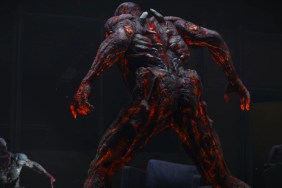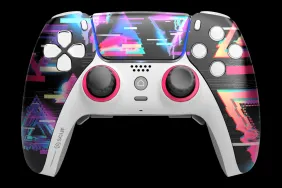Light up your life.
It’s often said that graphics do not make the game, and I generally agree. But
every so often, graphics play a key role in defining the game experience. Remember
Max Payne?
Such is the case with Ubi Soft’s Splinter Cell, which first grabbed
me by the collar and made me swallow my gum at the last E3 trade show in May.
It looked simply awesome, and others clearly agreed as it won all kinds of awards
(including one
from us). Would the final version do justice to its incredible coming out
party?
Yeah, pretty much. Though it suffers from some problematic design, this is
a superb Xbox offering and shows off the power of the system like none other.
The
game is sort of a cross between Metal
Gear Solid and the movie The
Professional. You play Sam Fisher, a veteran soldier and elite member
of a group called Third Echelon. You are sent in to uncover the secrets behind
the shady political dealings in the country of Georgia, though you’ll travel
the globe tracking down the root of the problem. You are not Rambo, however.
Stealth and cunning are your primary weapons. You come and go unseen. You are
a Splinter Cell.
Some video is employed to flesh out the story, usually in the form of a CNN-style
news feed delivered in between levels. It’s nicely presented, and though the
plot is hardly riveting, it gets the job done.
Spanning some 10 missions, the game takes single-player stealth action to a
whole new level of gadget madness and insane realism. You stick to the shadows
and spend most of your time sneaking past or disposing of guards and infiltrating
various buildings while accomplishing a collection of goals on each level.
Unlike the Metal Gear games, you do not get a magical line-of-sight
‘cone’ displayed onscreen showing where your enemies are looking. Instead, you
simply rely on a ‘light’ meter, which tells you how well-hidden you are, in
conjunction with a good sense of true sneaky behavior. Though you will have
access to occasional maps during some of the missions, none of them are very
helpful. It’s basically you and your instincts.
Thankfully, the control is very good for a game of this nature. The analog
control allows you to smoothly change your movement speed, which is essential
to controlling how much sound you’re making while moving. You can hug wall surfaces
ala MGS and shoot around corners.
But Splinter Cell ups it a notch with a variety of other cool moves.
You can grab on to wires or pipes and pull yourself along hand over hand, and
even hang from one hand while brandishing a pistol in another. You can perform
a ‘split jump’ in which you leap up and straddle a hallway from above, allowing
you to pounce down on an unsuspecting enemy like a ninja. You can even take
hostages by grabbing an enemy from behind and using him as a human shield while
pointing your gun at his frightened comrades.
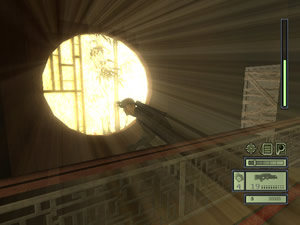 Splinter
Splinter
Cell separates itself from others of its kind with its terrific payload
of realistic and, at times, slightly futuristic weapons and gadgets. Sam can
use a pistol, frag grenades or a modular rifle (complete with sniper scope)
for the real dirty work, but he can also use less lethal ways of dispatching
enemies. Equip some ring airfoil ammo and aim for a headshot to knock a guy
out rather than kill him. Shoot a guy with a ‘sticky shocker’ and he’ll twitch
around and fall into a slumber. In fact, you can shoot a sticky shocker into
a pool of water, and any guards standing in it will be electrocuted. Mmmm…guard
stew.
Or how about a ‘distraction camera’? Just shoot it into a wall near an unsuspecting guard, then set off its noisemaker ability to lure him away from his post…or wait for him to get in range via its pan and zoom camera controls and set off its gas ability to knock him out. Very, very cool.
Other gadgets are useful for the more stealthy approach, like manual and combustible lockpicks, a portable camera jammer and an optic cable camera, which can be slipped under doors prior to entry. You can also equip thermal or night vision goggles in low light conditions. James Bond has nothing on Sam Fisher.
The combination of gadgetry and good control lead to a very playable, very
satisfying experience, in part because the AI is smarter than most. Sound plays
as important an issue as sight, and often you’ll alert the guards just by walking
too loudly. If you’re discovered, you’re likely dead in the water as the guards
will actually try to hunt you down. They are noticeably smarter than the ones
in MGS.
But what brings it all together is perhaps the most impressive graphics engine
powering any console game to date. Splinter Cell‘s looks take center
stage, as it’s just awe-inspiring in its beauty. Character models are spot-on
with rounded edges, smooth textures and accurate facial movement. The three
dimensional effect is so pronounced that at times they look like sculpted clay
figures rather than rendered objects.
The reason behind this is the lighting. Usually lighting warrants a passing
comment, but in the case of Splinter Cell, the lighting is perhaps the
most important part of the whole thing. Light filters through all kinds of objects
and materials; rays of sunlight might beam through cracks in a wooden crate.
Shadows are cast perfectly and appropriately. The lighting has a huge effect
on the gameplay, as it is the primary determinant as to whether or not you are
seen. Much of the game, therefore, involves the manipulation of light by shooting
out bulbs, switching off lights and being very careful where you choose to hide.
It makes for a dramatic, engrossing and very cinematic game.
Details abound in the world as well, from actual ticking clocks to eerily realistic physics, particularly hanging material like drapes, which react to the slightest touch. The fully 3D environments look terrific, and while not everything is interactive, it’s definitely immersive.
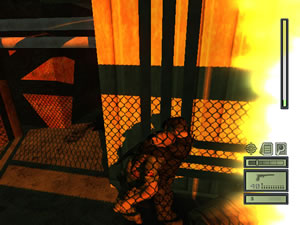 Michael
Michael
Ironside provides Sam’s voice, which is done well, and the rest of the voice
acting is adequate. The sound in general is pretty good, especially the different
sounds footfalls make on different surfaces.
When you put this all together, you wind up with an unmatched stealth-based
game. Trying to figure out how to overcome overwhelming odds without setting
off alarms makes for a strategic, slow-paced game of cat and mouse, and it’s
great fun.
However, Splinter Cell‘s long list of admirable qualities is hampered
a bit by some somewhat careless design flaws.
The biggest problem is the concept of "reward." The missions in
Splinter Cell are tied together loosely by the somewhat long-winded plot,
but what happens in one has no bearing on another. You start off a mission with
predetermined payload and gear, and you do not carry anything extra to the next
mission. This means you can use up everything you start off with since you’ll
be re-equipped at the start of the next mission, which is nice.
However, you are not rewarded at all for beating a mission stealthily, or
aggressively, or any way at all. You simply beat the mission and move on. There
is no ranking, no extra modes to open up and, since you don’t retain items,
no reason to try to get through a mission perfectly.
Further, Splinter Cell operates on a Checkpoint system during missions.
You wind up thinking less about the overall story or implications and focus
all of your efforts on doing whatever it takes to make it to the next checkpoint
in order to save your game. This breaks up the game flow and turns much of the
experience into pretty difficult trial and error.
Since there are no other modes and no rewards for being skilled, you’ll find
yourself playing in order to just move forward, which leads to a game with very
little replay value since it’s pretty linear. Some better design and continuity
here would have really made Splinter Cell feel much, much more complete.
It’s also a hard game, but that serves as a balance since there are really
aren’t very many missions. It’s too tough to beat in a weekend without using
a walkthrough, that’s for sure. The game comes packed with an Xbox Live! ‘Download’
option, which presumably will offer new levels and content, but currently nothing
is available.
Don’t let that sway you, though, because this is one of the best games to
come out for the Xbox this year. Its combination of great gameplay mechanics
and simply astounding graphics easily outweigh its faults. Trust me, you will
see the light.
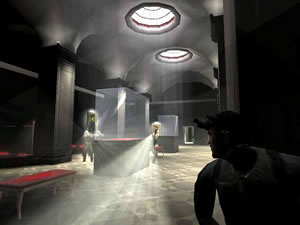
-
Fantastic graphics
-
Cool gameplay
-
Terrific gadgetry
-
Hard and fun
-
No rewards for skill
-
Limited replay value








